
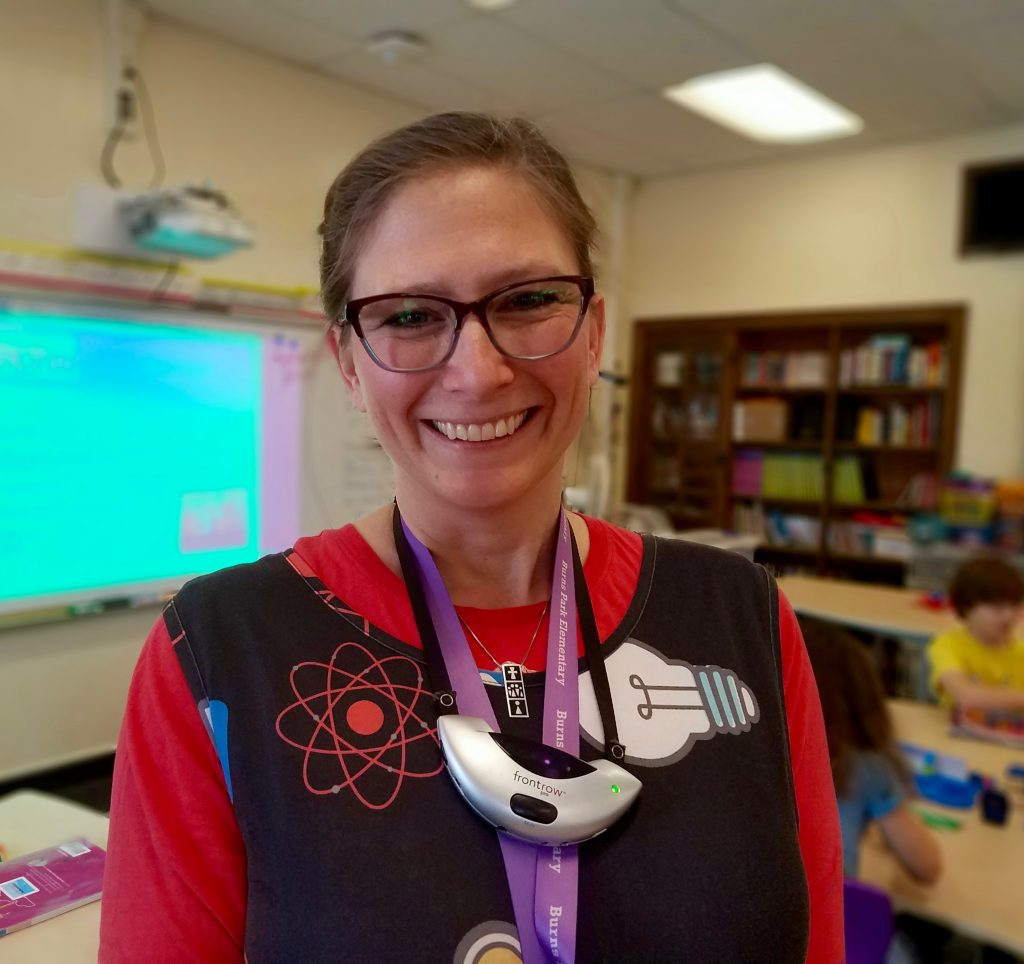
Profile and photos by Jo Mathis/AAPS District News Editor
Lisa Ziegler grew up in Hastings and attended Hastings Area Schools, as did her two younger brothers, Mike and Jimmy. Her father, Dave Storms (who now works as a magician) was the executive director of the YMCA of Barry County. The family lived at Camp Algonquin in Hastings each summer, as her father also served as the camp director. Her mother, Debbie, went back to school when the three children were all in school to become an elementary school teacher. Ziegler has fond memories of going to class with her mother at Michigan State University and being a test subject for aspiring teachers.
Starting in ninth grade, Ziegler worked at Camp Algonquin every summer as a counselor, program director, and assistant camp director until she graduated from college—except for the one summer when she worked as program director of Camp Chief Ouray Day Camp at the YMCA of the Rockies, Winter Park. While in college, she also attended Disney University, where she earned her (no kidding) “Duck-torate” degree and had the honor of driving double-decker buses to various countries at EPCOT. She graduated from Grand Valley State University with a major in group science (emphasis: biology) and a minor in elementary education.
Ziegler taught fifth grade in Canton, Ohio and then third and fourth grades in Atlanta while her husband attended seminary at Emory University. She then stayed home raising their three children: Mary, now 14, Annie, 12, and Charlie, 8. It was when Charlie started kindergarten that she returned to teaching, this time for Ann Arbor Public Schools. Ziegler taught kindergarten at Lawton elementary for three years before she began teaching Project Lead the Way at Burns Park this year.
Her daily passion is to live out her personal mission of placing faith first, others second, and herself third.
Watch a video of Ziegler making science relevant to her students by connecting the concept of collision to Shaun White winning a gold medal at the Olympics:
First things first. Tell me about your work uniform. My 9th graders never cease to roll her eyes at my outfits. My work wardrobe radiates—hopefully—a joy of life.
Through my own children and children that I teach, I have grown a love for leggings. Last year, a dear kindergarten student insisted that I have a pair of princess leggings, so she had her family gift them to me. Since then, leggings have been the gift to get Mrs. Ziegler (or Mom, if you ask my own kids). It’s also turned into a way I connect with students when we coordinate our outfits and/or hairstyles. The shirts I wear are in the hopes of bringing joy through science puns, “Life is Good” messages, Disney characters and superheroes. I also love character shoes. My own kids designed me a pair of All-Star shoes with “Mrs. Z.” on them.
I wear what makes me smile, brings joy to others and laughter to all—and maybe a little of Ms. Frizzle. There usually is a story—or love, laughter or kindness—behind each outfit.
What inspired you to become a teacher? Wow. So many things. Actually, so many people! I continue to be inspired daily through my practice of teaching. This inspiration started with my grandparents, parents, and brothers. They created a joyful family environment that encouraged creativity, collaboration, inspiration, and kindness. While working as a camp counselor, I discovered the joy of encouraging the leaders of tomorrow to be caring, respectful, responsible, honest and inclusive. Through these core values, our world has the potential to be full of joy. Once we have that sense of joy, one can begin to learn. And with this learning comes inspiration to change the darkness of our world into light. Inspiration to be a teacher certainly took shape during my Camp Algonquin years. My faith has also challenged me to look deeply into my heart and to see where can I make the most positive impact that helps inspire others to change our world to be full of the kindness and respect we all desperately need it to be.
Did you have a Plan B? I was originally going to school to become a physical therapist. I have always loved science and had been inspired by a physical therapist who helped me along my journey of overcoming significant sport-induced knee injuries. However, in my practicum, I realized that I was not gifted with the skills to bring inspiration to the older generations. Through the inspiration of my parents’ careers, working at Disney World, and my vast experience with the YMCA, I realized that teaching children was where my passion, inspiration, and joy came from. I discovered how I could combine my love for science with my love for inspiring children to be inquisitive, intelligent, creative, kind and joyful by becoming an educator.
How do you like teaching a range of age groups rather than being a classroom teacher? I absolutely love my position as a PLTW teacher. I love being inspired by children of all ages. Through the project-based learning and STEAM teaching styles, children are able to learn from one another—not only about relative subjects, but also about working together, listening with a kind heart and learning from and challenging each other. In a world where school shootings are becoming more and more common while supposed adult role models are speaking with anger and judgment, anxiety and depression are becoming normalized. We need to teach students to act with kindness, respect diversity, talk with joy and empathize with others. PLTW provides students an enormous platform not only to learn about science and engineering, but also how to be a kind, positive, creative, empathetic and inspirational citizens of our world.
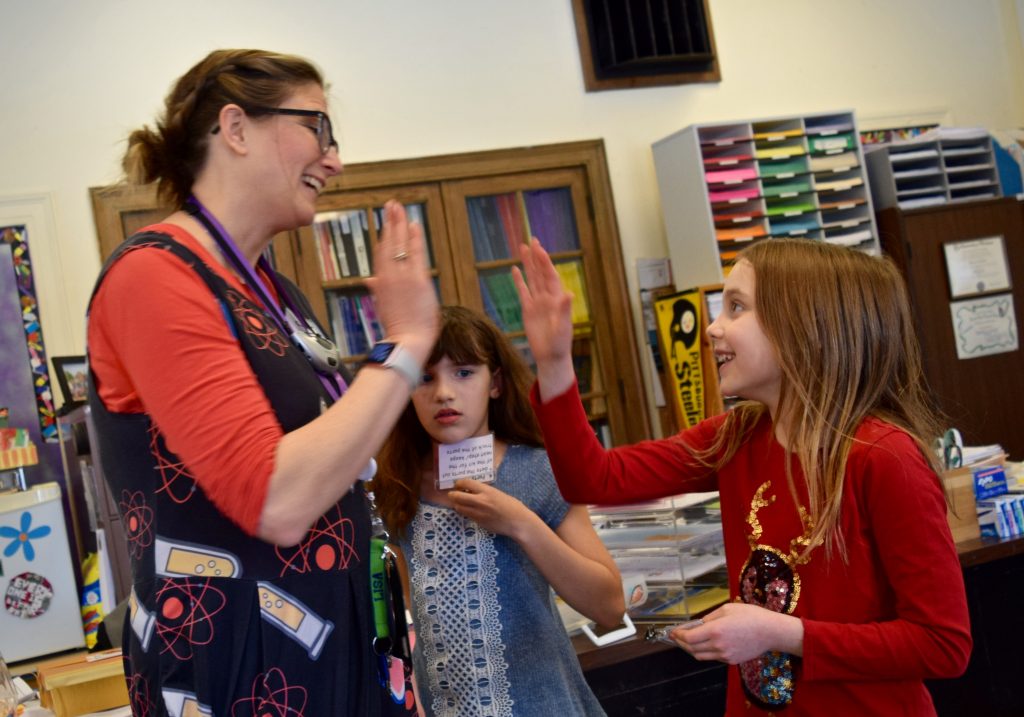
Your enthusiasm for science is impressive. Does it come naturally? Thank you! What a nice compliment! I would say that it only comes naturally insofar as the students’ energy and positive responses towards the project-based learning and STEAM style fuels me with enthusiasm. The AAPS PLTW cohort is a group of teachers that share this same passion and through our collaborations and love for the subjects, I gain much of my enthusiasm. Burns Park students are eager to ask questions and hungry to learn. I love that through PLTW, they are encouraged to ask questions and research the answers by assuming ownership of their learning, all while kindly and collaboratively working with others. I also keep the end in mind as I am teaching. If one student might be inspired through my energy and love for science to change our world for the better, I have a duty to bring that energy to my teaching. I have found that what I put out through teaching, I receive back exponentially.
How do you keep students engaged? When I teach PLTW, I not only teach the standards, I also teach and model how to work as a team. Part of working as a team is inspiring everyone to have an active role in the design process. Discovery of core standards is key—not through lectures, but through hand-on projects that require students to work and learn collaboratively with kindness and inspiration.
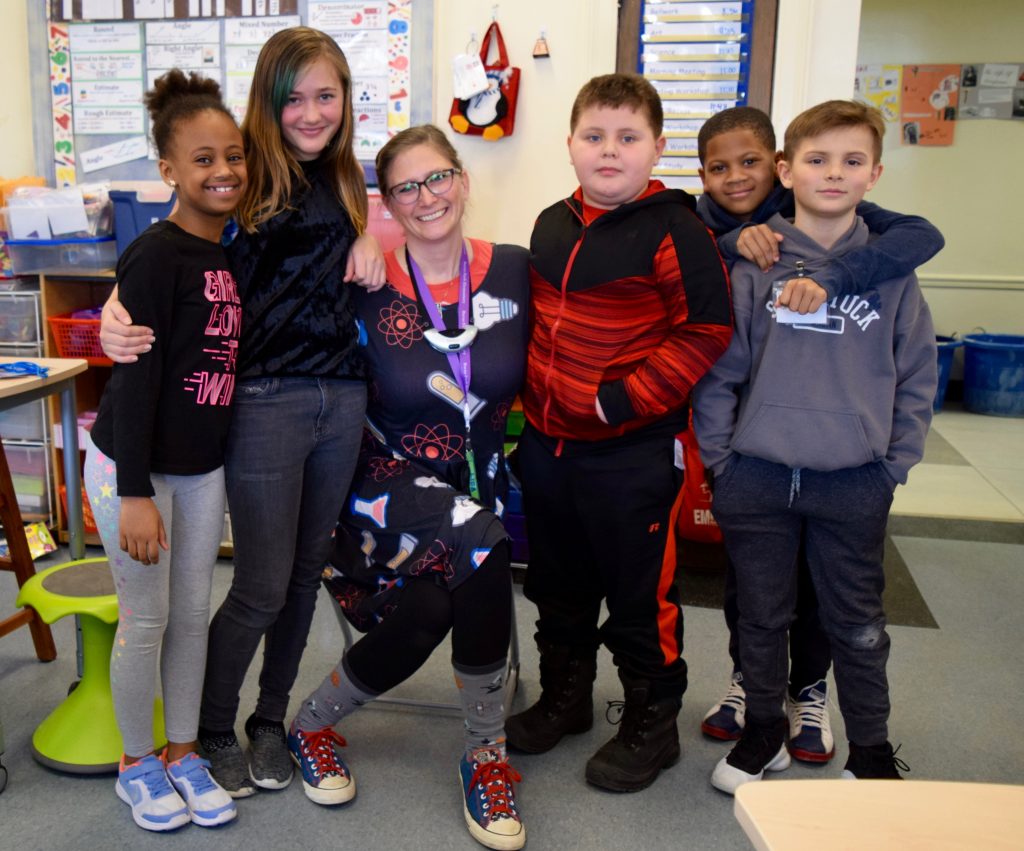
In your four years in AAPS, what’s the most important thing you’ve learned about teaching? Diversity truly is our strength. When teaching, differentiating through collaboration with teachers, parents and students is key to achieving optimal learning—not just for students, but for teachers as well. I hesitate to even consider myself exceptional, as the only reason one would recognize me as exceptional is for the support (through constructive criticism and inspiration) that I receive from colleagues, students and parents. I am surrounded by exceptional people with a passion for teaching and exceptional students and families with a passion to learn. AAPS sure knows how to hire the best of the best teachers. What an honor it is to work with so many of them!
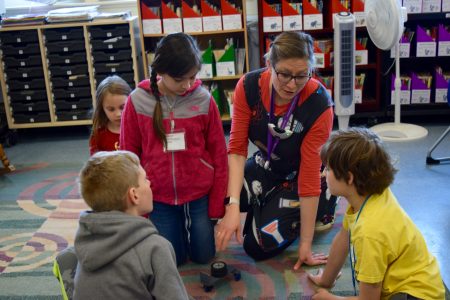
Describe an average workday. Our family of five wakes up around 6 a.m. We have breakfast (made so wonderfully by Dad), then I drive my 9th grade Community High School student to the bus stop, then drive back to pick up Charlie—a STEAM student—and drive him to his bus stop. I treasure the 15 minutes I get with Charlie before the bus arrives. We read a chapter book (right now it’s “Wonder”) and talk about how we are going to bring kindness into our day. After he challenges me to bring kindness to others, I drive to Burns Park. I look for inspiration by making time to chit-chat with my amazing Burns Park colleagues in the morning, then set up my “push in” classroom for the day. (I “push-in” to classrooms and team teach with classroom teachers, so I don’t have a classroom. My cart is my office.) I enjoy morning bus duty in which I get to greet parents and students arriving at school. This practice also fuels my positive energy. I usually teach three to four classes from 9:10 to 11:30, followed by a lunch break in which I need to “de-program” through listening to upbeat music—usually a little Justin Timberlake—and gear up for the afternoon. I usually start at 12:45 and continue until the end of the day, again, teaching three to four classes. I head home and enjoy time with my family (dinner, yoga, tennis, reading parties and an occasional “Stranger Things” or “Dancing with the Stars.”
What advice would you give to a first-year teacher? Do what brings you joy. You can’t expect joy from others unless you can put joy out into the world. Once something stops bringing you joy, don’t settle. Look for the inspiration. Seek out those that are joyful. Continue to be eager to learn, love and laugh. Teach with kindness and enthusiasm. What you put out into your classroom, you will receive.
Favorite websites: Wonderopolis. Newsela. Seesaw. Epic!
Apps you can’t live without: without: Seesaw. Daily Wonder, Whatsapp, Twitter.
What’s your favorite to-do list manager? My iPhone with alarms, iCal, & Reminders.
What is the most rewarding part of teaching? Being inspired by others through their excitement towards learning, creating, collaborating, teaching, discovering and empathy towards others.
What has surprised you most about the profession? How lonely it can be. One must actively seek out others to help find inspiration and gratefulness. As teachers, we need administration to inspire and recognize the successes in our practices, as well as, encourage us to evolve and learn new practices. We need teachers to be our 8-4 work family (to lift us up, to celebrate and cry with us and be an inspiration to us), we need parents to see their child’s education as a partnership, and we need to actively seek time to reflect, rest and breath (and we need to teach this to our students, too).
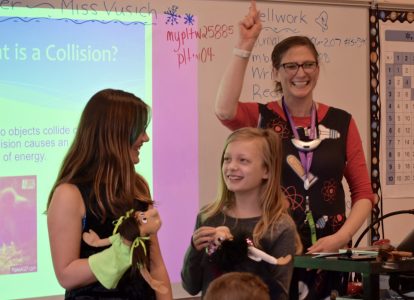
What do you wish everyone realized about the work of a teacher? When your children are in our classroom, we love them like they are our own. We fight relentlessly for them during school, as if they were our own. We not only care about their academics, we care about how they treat others and treat themselves. We strive to inspire them to love unconditionally, speak with absolute kindness, create without worry of failure, learn with ownership, and empathize with each other’s strengths and weaknesses.
How do you recharge? By spending quality time with family and friends, along with, yoga, tennis, church, laughter, date nights, and U-M women’s basketball (Go Blue!). Not necessarily in that order.
What’s most exciting about your professional life right now? Teaching a program that I full-heartedly believe has the power to teach students the skills to bring joy and kindness into our world of many problems. Through students and teachers working together, connecting all core academic subjects and creating solutions to relevant world problems, students—through the foundations of PLTW—can inspire those around us to be better. We can be better. We need to be better. These students are on the brink of greatness. How exciting is that?
What’s most exciting right now about your personal life? Raising a family that has the skills to make our world a place where love can triumph all even in the darkest of days. We do this through taking a weekly Sabbath day, celebrating our faith practices, learning together about our world through travel and sitting and eating together as a family.

Be the first to comment